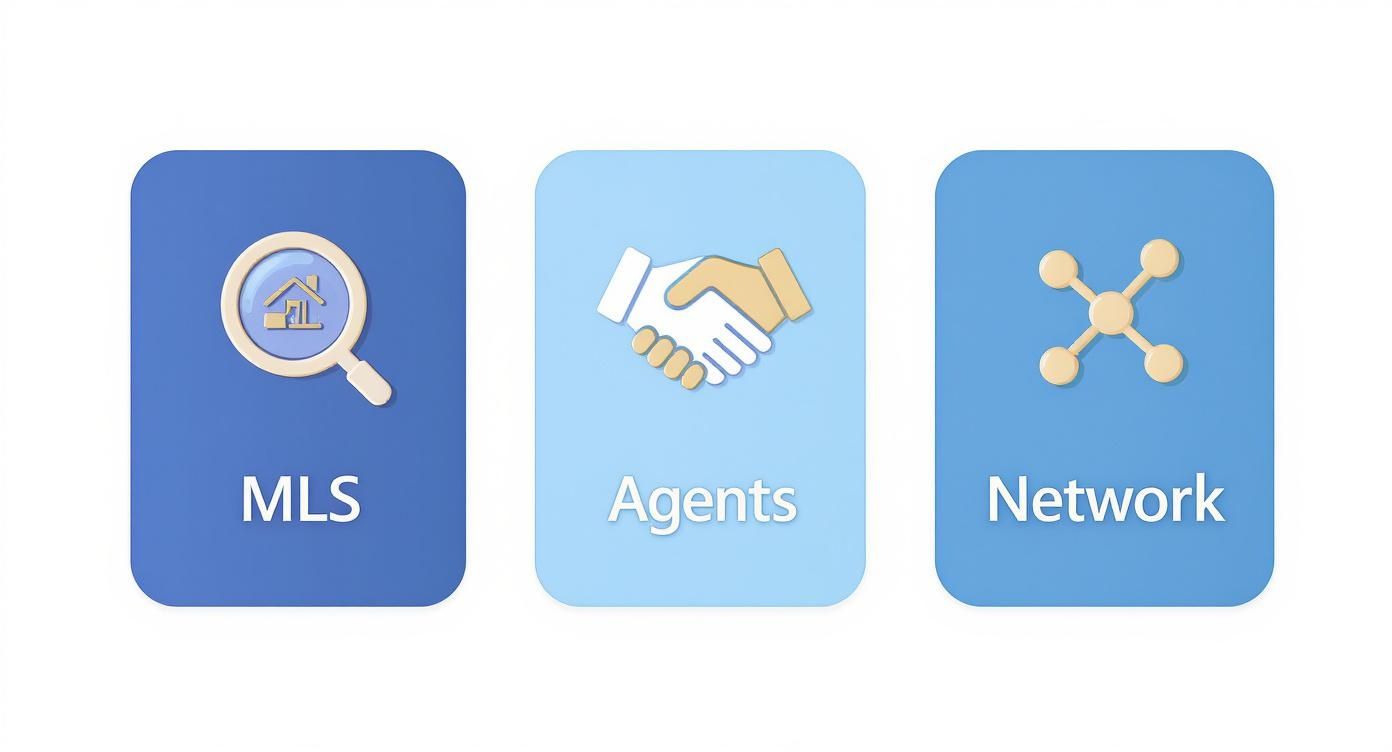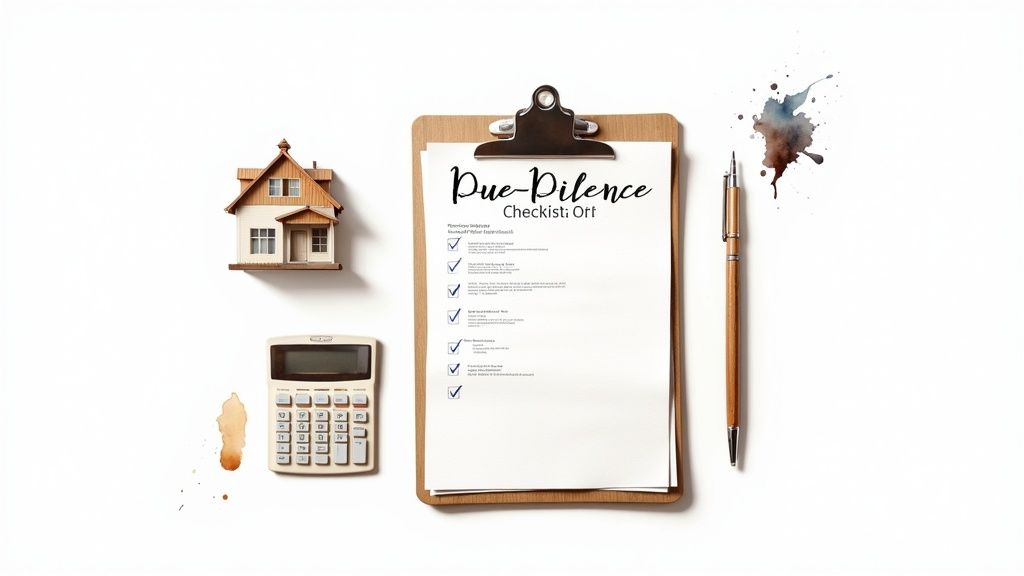How to Find Pre Foreclosure Homes
Discover how to find pre foreclosure homes with our guide. Learn proven methods to uncover valuable real estate deals before they hit the market.
By James Le
Finding a pre-foreclosure home is like finding a hidden door in the real estate market. It's a chance for investors and savvy homebuyers to find a great deal long before it hits the mainstream and the competition gets fierce.
So, what exactly is a pre-foreclosure? It’s a property where the owner has fallen behind on mortgage payments, but the bank hasn't officially taken it back through auction yet. This creates a unique, often short, window of opportunity.
Your Guide to Pre-Foreclosure Properties
Unlocking these opportunities means you get to talk directly with a motivated homeowner. This isn't just about getting a discount; you're often stepping in to provide a genuine solution for someone in a tough spot.
The clock is ticking during this phase. The homeowner still holds the title to the property and is often desperate to sell quickly. A fast sale can help them avoid the devastating credit impact of a full-blown foreclosure, and that's where you come in.
It's a delicate situation, and understanding the human element is key. You're not just hunting for a bargain; you're helping someone navigate a financial crisis. This guide will give you the real-world strategies to do just that—from digging through dusty county records to tapping into professional networks and specialized online tools.
What This Guide Covers
We're going to break down the exact methods the pros use. Think of this as the high-level map before we dive into the nitty-gritty details in the following sections.
You’ll learn how to:
- Track down Notices of Default at the county courthouse.
- Find real estate agents who live and breathe distressed properties.
- Use online listing services to get ahead of the curve.
- Reach out to homeowners with an approach that is both effective and empathetic.
The market for these properties is bigger than you might think. In the third quarter of this year alone, there were about 222,318 homes in pre-foreclosure across the United States. A small but fascinating slice of these are "zombie" properties—around 7,519 abandoned homes that signal pockets of distress even when the broader market is hot. You can dig into more of this data over at The Mortgage Point.
It's also crucial to see things from the other side of the table. Homeowners have their own strategies for how to sell a house before foreclosure, and understanding their mindset gives you a massive advantage. When you can approach a seller with empathy and a real solution, you stop being just another investor and become a welcome way out. This guide will give you that edge.
Before we dive deep into each tactic, here's a quick look at how the different methods stack up. This should help you decide where to focus your energy first.
Methods for Locating Pre Foreclosure Homes
| Method | Cost | Effort Level | Best For |
|---|---|---|---|
| Public Records | Low (free to minimal fees) | High | DIY investors who want to be first and aren't afraid to do the legwork. |
| MLS & Agents | Medium (agent commissions) | Low | Buyers who prefer professional guidance and filtered, vetted opportunities. |
| Auction Sites | Varies (platform fees) | Medium | Experienced investors comfortable with competitive bidding and due diligence. |
| AI-Powered Tools | High (monthly subscriptions) | Very Low | Serious investors looking to scale their search with data-driven precision. |
Each of these paths can lead to a great deal, but they demand different levels of time, money, and expertise. Now, let's get into the specifics of how to execute each one.
Using Public Records to Find Hidden Deals
If you want to get ahead of the competition, public records are where the real work begins. This is the ground-floor, the absolute starting point for finding pre-foreclosure homes. You're tapping into the paper trail before a property is widely marketed, giving you a massive head start.

The whole process kicks off when a homeowner falls behind on their mortgage payments. After a few missed payments, the lender is legally required to file a public notice. Think of it as a flare signal—it's the very first public indication that a homeowner is in distress and a potential deal is on the horizon.
Decoding the Key Documents
You'll find these notices have different names depending on where you are, but they all signal the same thing: the foreclosure process has started. The two big ones you'll run into are the Notice of Default (NOD) and the Lis Pendens.
- Notice of Default (NOD): This is usually the first shot across the bow. It's a formal document from the lender that says the borrower has defaulted. It will clearly state how much is owed and give the homeowner a window of time to get current on their payments.
- Lis Pendens: This one sounds fancy—it's Latin for "suit pending." It's a notice filed with the county that a lawsuit has been filed against the property. In our world, that lawsuit is the foreclosure action.
Finding these documents is your mission. They’re packed with the critical details you need: the homeowner's name, the property address, and who the lender is. This raw information is gold for figuring out if a property is worth pursuing.
Where to Search for Public Records
Alright, you know what to look for. Now, where do you find it? Most of this stuff lives at the county level, and you’ve got a couple of ways to dig in.
The easiest place to start is the county recorder or clerk's website. Many have online databases you can search. Be warned, though—a lot of these government websites look like they haven't been updated since 1998. The search functions can be clunky, so you'll need some patience.
For a more old-school but often more effective approach, take a trip down to the county courthouse. You can access the physical records, and I’ve often found details there that never made it online. If you really want to get serious, it's worth understanding what professional title abstractors do; these experts live and breathe public record research.
Once you find a notice that looks promising, your job is to pull out the key data points. You're looking for the outstanding loan balance, the date the notice was filed, and any other debts or judgments attached to the property. This helps you build a financial snapshot and decide if there's enough equity to make a deal work.
As you start collecting this data, you might want a better way to see where the opportunities are clustering. A great next step is learning how to create a heat map to visually organize your target properties and spot neighborhood trends.
Working with Real Estate Agents and the MLS
It’s a common myth that pre-foreclosure homes are some kind of hidden, off-market treasure. And while many are, you'd be surprised how many homeowners list their properties on the open market as a last-ditch effort to avoid foreclosure. They'll bring in a real estate agent and put it right on the Multiple Listing Service (MLS).
This creates a powerful—and often overlooked—avenue for savvy buyers who know what they're looking for.
The key is partnering with the right kind of real estate agent. You don't just need someone with a license; you need a specialist who lives and breathes distressed properties. These pros often hold special designations like Certified Distressed Property Expert (CDPE) or have their Short Sales and Foreclosure Resource (SFR) certification.
A great agent can set up custom MLS searches that go way beyond the standard filters. They know the lingo and the subtle status changes that signal a pre-foreclosure deal, even when the listing doesn't scream it from the rooftops.
Uncovering Deals on the MLS
So, how do you actually find these properties? Your agent can zero in on listings by searching for specific terms in the public or agent-only remarks sections. These keywords are clues that the seller is in a tight spot and highly motivated.
Here are some of the most effective search terms to get you started:
- "Short sale" or "subject to bank approval": This is your most direct signal. It means the seller owes more than the property is worth, so the lender has to approve the final sale price.
- "Lender approval required": Very similar to a short sale, this phrase tells you a third party—the bank—has the final say.
- "Must sell" or "bring all offers": While you'll see these on regular listings, they often point to a seller who needs a quick exit strategy, which can absolutely include those in pre-foreclosure.
A killer agent won't just stop at keyword searches. They'll also hunt for properties that have had recent, significant price drops or have been sitting on the market way longer than the local average. These are classic signs of a seller running out of time and options.
Building a Powerful Professional Network
While the MLS is a fantastic tool, the real gold is in the relationships you build. Your agent is just the first domino in a powerful network that can bring you deals before they even sniff the open market.
Think about it: who's the first to know when a homeowner is in financial trouble? It's often their real estate agent, a title company officer, or a real estate attorney. These professionals are in the trenches, dealing with the paperwork and tough conversations long before a Notice of Default is ever filed.
By building genuine connections with these folks, you position yourself as the go-to investor for their distressed clients. Let them know you’re a serious buyer who can close quickly and offer a reliable solution for homeowners facing a tough situation.
A simple introduction and a clear explanation of what you're looking for can put you at the top of their call list. This inside track is one of the most effective ways to find deals no one else even knows exist.
Using Online Listing Services to Find Properties
If you'd rather not spend your afternoons digging through dusty courthouse records, online pre-foreclosure listing services are your best friend. These platforms do the heavy lifting for you, pulling together data from public records, MLS feeds, and other sources into a single, searchable database. It's the difference between manual labor and getting targeted leads sent right to your inbox.
And let's be clear: the market for these properties is heating up, making the right tools more critical than ever. In September alone, foreclosure starts in the United States hit 23,761—a 20% jump from the previous year. With one in every 3,997 housing units nationwide feeling the pressure, having a platform that can quickly surface opportunities is a massive advantage. States like Florida, Delaware, and Nevada are hotspots. You can get a much deeper look at these numbers by reviewing the latest foreclosure market reports from ATTOM Data Solutions.
Free vs. Paid Platforms
Right off the bat, you have to decide whether to stick with free tools or pony up for a paid subscription.
Free platforms like Zillow Foreclosures are a decent place to get your feet wet. They give you a feel for the distressed property landscape in your target area without asking for a credit card. It’s a no-risk way to start your research.
But when you're ready to get serious, paid services like Foreclosure.com and RealtyTrac are where the real action is. They offer data that’s fresher, more detailed, and far more accurate.
Think of a paid subscription as an investment in speed and efficiency. That monthly fee often pays for itself the first time you get access to a great property days—or even weeks—before it pops up on a free site. That head start is everything.
Comparing the Top Services
While there are a ton of services out there, a few big names really dominate the space. Each one has its own flavor, offering a different mix of features, data depth, and user experience that caters to different kinds of investors.
Here’s a quick rundown of what to expect from the major players.
| Platform | Subscription Cost | Key Features | Data Source |
|---|---|---|---|
| Zillow Foreclosures | Free | Basic search filters, property history, Zestimate. | Public records, MLS, user submissions. |
| Foreclosure.com | ~$40/month | User-friendly interface, detailed property info, educational resources, 7-day free trial. | Government agencies, banks, public records. |
| RealtyTrac | ~$50/month | In-depth analytics, auction details, neighborhood data, advanced filtering tools. | Public records, MLS, proprietary data partnerships. |
Choosing the right tool really depends on your experience and how deep you want to go. For someone just starting, Zillow is perfect for getting a lay of the land. But for investors who live and breathe data, RealtyTrac’s powerful analytics are tough to beat.
At the end of the day, no single tool is a magic bullet. Your best strategy for finding pre-foreclosure deals will always be a mix of methods—from networking with agents and scouring the MLS to leveraging these powerful online platforms.
This infographic really brings it all together, showing you the main channels you should be tapping into.

By weaving together MLS access, strong agent relationships, and professional networking, you build a powerful, multi-channel system for sourcing opportunities. The best online services are the ones that complement these efforts, helping you move faster and make smarter decisions with better information.
Go Direct to the Homeowner
While real estate agents and online platforms have their place, the real magic—and the most profitable deals—often happens when you go straight to the source. This means reaching out to distressed homeowners directly, long before their property ever sees the light of day on a listing service.
It's a proactive strategy. You get to be the one who offers a solution to their problem, which not only helps them out of a tough spot but also lands you a fantastic investment opportunity.

This isn't about just finding deals; it's about creating them. By making a personal connection with someone facing a difficult financial situation, you're operating in a space with virtually no competition. It takes more hustle, for sure, but the payoff can be massive.
The Art of the Empathetic Direct Mail Campaign
Direct mail is the classic, time-tested foundation of this approach. But let's be clear: your message is everything. A poorly worded letter can feel predatory and get tossed in the trash immediately. A thoughtful, empathetic one, however, can position you as a genuine problem-solver.
Your entire goal is to build a sliver of trust, not to strong-arm a sale. Keep your message clean, respectful, and laser-focused on offering a helpful way out.
Here’s what I’ve found works best in these letters:
- Make it personal. Always use the homeowner's name and reference their property address. This simple step shows it isn't just another piece of junk mail.
- Keep it simple and clear. State that you buy houses in their area and can close quickly. Frame it as a potential solution, not a demand.
- Lead with empathy. Acknowledge that they might be going through a difficult time. Let them know you’re there to offer a fair, no-pressure solution.
- Offer multiple ways to connect. Include your phone number, a professional email address, and a simple website. Let them choose how they want to reach out.
A quick tip from experience: Ditch the aggressive sales talk. Phrases like "I want to buy your house" or "Final notice" are instant turn-offs. Instead, try softer language like, "I'm interested in your property on Elm Street," or "I may have a solution that can help." This empathetic tone is far more likely to get a call back.
Of course, this whole strategy falls apart if your letters don't reach the right person. Once you’ve pulled a list of properties from public records, using the best skip tracing service is non-negotiable. It's how you find the homeowner's correct current mailing address and phone number, ensuring your message actually lands in their hands.
Get Your Boots on the Ground
Beyond the mailbox, a few other old-school, hands-on tactics can unearth pre-foreclosure gems before anyone else knows they exist.
Driving for Dollars This is exactly what it sounds like, and it’s one of the most effective methods out there. You get in your car and drive through neighborhoods you're interested in, actively looking for properties that show signs of distress. Think overgrown lawns, newspapers piling up, boarded-up windows, or a roof that's seen better days. These are often visual cues that a homeowner is struggling and might be open to a conversation.
Network with Key Professionals Building relationships with probate attorneys, divorce lawyers, and bankruptcy trustees can be an absolute goldmine. These professionals are on the front lines, dealing with people in tough situations every single day. They often know about distressed properties months before they hit the market.
Introduce yourself, explain what you do, and position yourself as a reliable, fast-closing buyer who can make their clients' lives easier. A good referral from a trusted professional is priceless.
What to Do Before You Make an Offer
So you’ve found a promising pre-foreclosure property. The thrill of the hunt is real, but this is where the real work begins. Too many investors get caught up in the chase and forget that unearthing a potential deal is only half the battle. Now, it's time to shift gears from researcher to meticulous investigator.

This final stage demands patience, empathy, and a healthy dose of professional skepticism. You're not just buying a house; you're stepping into someone's complex financial life. Overlooking a single detail can quickly turn a golden opportunity into a costly nightmare.
Approach the Homeowner with Sensitivity
First things first: remember you’re dealing with people going through a profoundly stressful time. Whether you reach out with a letter or a phone call, your approach has to be professional and empathetic. Frame yourself as a problem-solver who can offer a fair, fast solution—not a predator circling a bargain.
A little rapport goes a long way. Listen more than you talk. Make it crystal clear that you're offering a respectful, no-pressure alternative to foreclosure. This human touch is often the one thing that separates successful investors from those who get ignored.
The key is to present a win-win scenario. The homeowner gets to avoid the credit-destroying impact of a formal foreclosure, and you get the opportunity to purchase a property with built-in equity.
And this is a good time to be having these conversations. In the first half of this year alone, 187,659 U.S. properties entered some stage of foreclosure filing, a 5.8% jump from the previous year. You can discover more about this upward trend in housing distress, which underscores why a solutions-focused buyer like you is more important than ever.
Conduct Meticulous Due Diligence
Before you even think about running the numbers, you have to verify every single claim against the property. A professional title search is absolutely non-negotiable. This is your only defense against hidden liens, judgments, or other nasty surprises that could kill the deal or become your problem after closing.
I've seen it all. Common issues that pop up include:
- Unpaid property taxes
- Second or even third mortgages
- Mechanic's liens from contractors who were never paid
- IRS tax liens
Every one of these must be settled at closing, and each one eats directly into your potential profit margin. Never, ever take the homeowner’s word for it. Trust the official title report and nothing else.
Navigate the Short Sale Process
If the homeowner owes more on their mortgage than the house is actually worth, get ready to enter the world of the short sale. This means the lender has to approve the sale because they are agreeing to accept less than the full amount they are owed.
Be prepared for a long, often frustrating journey. Lenders are massive bureaucracies, and they move at a glacial pace. You’ll be required to submit a mountain of paperwork, including your purchase offer, a hardship letter from the seller, and all sorts of financial statements.
Lender approval can drag on for months, with zero guarantee they’ll accept your offer in the end. Patience is your greatest asset here. Having an agent who has navigated the short sale gauntlet before is a massive advantage. It's also wise to understand all the pros and cons of buying a foreclosed home to get a full picture of what you're stepping into.
At Tab Tab Labs, we provide a curated directory of the latest AI-powered tools designed to give real estate professionals a competitive edge. From identifying distressed properties to automating your marketing, explore our resources to make your next investment smarter and more efficient. Visit us at https://tabtablabs.com.